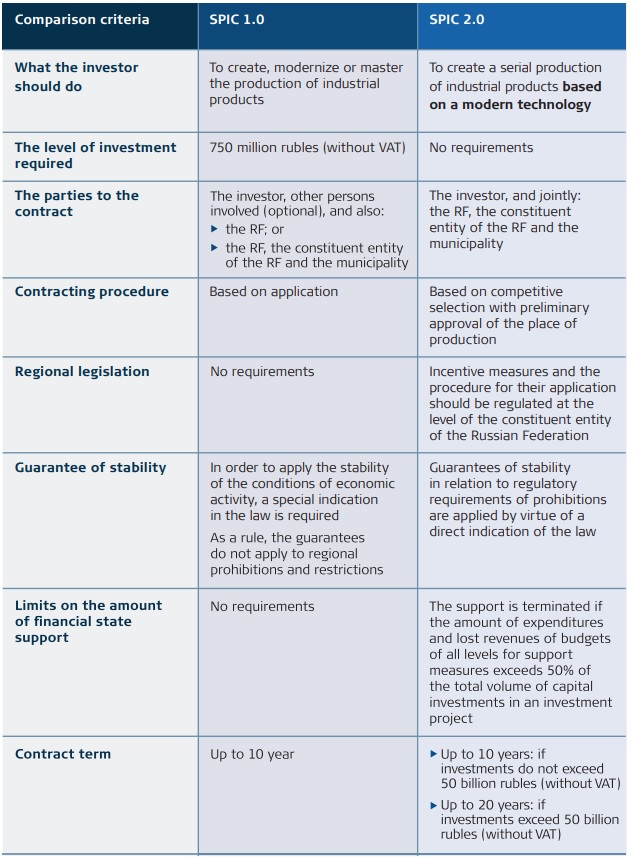On 14 March 2022, a law came into force reviving the SPIC 1.0 mechanism for new investment projects, and allowing extending the terms of contracts already concluded due to foreign sanctions1. The amendments were developed by the Government as part of a package of anti-crisis measures.
As part of the development of this law, the Government has also clarifi ed the rules for concluding SPIC 1.02. The updated rules came into effect on 1 April 2022.
Under SPIC 1.0, an investor has the right to receive preferences similar to those provided for under SPIC 2.0: guarantees of stability of tax and regulatory conditions; tax benefi ts; simplifi ed acquisition of the "Made in Russia" status; the possibility of applying accelerated depreciation; special conditions for leasing public land; industry subsidies, etc.
In this review, we will take a closer look at the new regulation and pay attention to the key differences between SPIC 1.0 and SPIC 2.0.
I. The right to conclude new contracts under the clarifi ed rules
The SPIC 1.0 format has been unavailable to investors since August 2019, after the Ministry of Industry and Trade carried out a radical reform of this mechanism by offering SPIC 2.03 to investors.
The amendments exclude the blocking of SPIC 1.0. It is expected that the former SPIC structure is a tool that will help stimulate the implementation of new investment projects on creating and modernizing industrial activities in Russia in the face of foreign sanctions.
The rules for concluding SPIC 1.0 have been simplifi ed. Thus, to conclude a contract, it will no longer be necessary to provide information about the planned indicators of international competitiveness (diversifi cation of supply coeffi cient).
Changes in the rules have affected also the form of the SPIC 1.0. In particular, the grounds for changing or terminating the SPIC at the request of one of the parties have been clarifi ed, and the occurrence of force majeure circumstances that are connected with international sanctions4 preventing the implementation of the project may serve as a basis.
II. Conditions required for the extension of existing contracts
By default, the new law allows to extend the SPIC if the following conditions are met:
1) The SPIC was in effect on the date the law entered into force — 14 March 2022.
2) The contract was concluded with the participation of the Russian Federation, that is, the law does not provide for the possibility of extending regional SPIC.
3) International sanctions have been imposed on Russia, the investor or other persons specifi ed in the SPIC, and these sanctions hinder the implementation of the investment project under the SPIC.
The maximum term of the contract after it is extended shall be up to 12 years5.
The Government has the right to establish additional rules for both modifi cation and termination of the existing SPIC 1.0.
Similar grounds for extending the validity of contracts already existed for investors under the SPIC 2.0.
The innovation is aimed at helping investors who concluded the SPIC 1.0 between 2016 and 2019, whose projects are in the active phase of implementation, and are therefore most vulnerable to international sanctions.
III. Key differences between SPIC 1.0 and SPIC 2.0
SPIC 2.0 is still there for investors. As the lawmaker of the new law on SPIC 1.0 has explained, present circumstances require the parallel application of both mechanisms of special investment contracts.
Let us consider what the fundamental differences between these mechanisms are now.
What the investor should do. The foundation of SPIC 2.0 is modern technologies. Based on such a modern technology from the government list6, the investor should create a serial production of industrial products. This format is focused on long-term private investments in hightech projects. SPIC 1.0, in turn, is simpler and more versatile: it does not require the inclusion of technology in a special list through the Government and is used for a wide range of projects to create, modernize or master the production of industrial products.
The level of investment required. With relation to SPIC 1.0, the minimum investment in the project must be 750 million rubles (without VAT). For SPIC 2.0, there are no conditions for the "entry threshold" for the level of investments, but when evaluating an investor's application as part of a competitive selection, the commission takes into account the volume of products that the investor plans to produce under the SPIC.
The parties to the contract. SPIC 2.0 involves an investor and a public party, which necessarily includes federal, regional and local authorities. SPIC 1.0 may be concluded with the Russian Federation, both with and without the participation of the region and municipality in which the investment project will be implemented. Moreover, unlike SPIC 2.0, the fi rst generation of SPIC allows the involvement of other persons for participation in the contract (manufacturers and distributors of products, engineering and fi nancial centers, etc.).
Contracting procedure. To conclude a SPIC 2.0, an investor must pass a competitive selection. As a rule, contracts are concluded with one or more winners of the selection. Before taking the initiative to conclude SPIC 2.0, the investor must coordinate with the constituent entity of the Russian Federation and the municipality the place of production. On our estimates, the deadline for concluding SPIC 2.0 from the moment the investor's preparatory work begins may range from 5 months to 1 year. There are no competitions for SPIC 1.0, and the investor's application is evaluated as it is received. The period from the moment of fi ling an application for the conclusion of SPIC 1.0 to the moment when the agreed draft contract is sent to the investor is up to 90 working days.
Regional legislation. SPIC 2.0 cannot be concluded if there is no regulatory framework on incentive measures and the procedure for their application at the level of the constituent entity of the Russian Federation acting as a party to the SPIC. No such requirement has been established for the fi rst generation of SPIC.
Guarantee of stability. Both mechanism provide the investor with a "grandfather clause", but the stabilization rules differ signifi cantly.
Under SPIC 2.0, the law promises the investor stability of the conditions of economic activity. This rule applies if a special procedure for "not worsening" is provided by law on the date of the conclusion of the SPIC (that is, the adoption of the relevant law is necessary for obtaining the preference). At the same time, stability is not guaranteed when restrictions and prohibitions are imposed by regions and municipalities7.
The stabilization clause that SPIC 1.0 provides in relation to regulatory requirements and prohibitions looks less vague and more profi table. Firstly, it applies to each private party of the SPIC in relation to all key elements of the industrial products life cycle and processes related to these products8. Secondly, it works solely by virtue of the direct instructions of Federal Law No. 488-FZ dated 31 December 2014 "On Industrial Policy in the Russian Federation" (Part 5 of Article 16).
Both SPIC 1.0 and SPIC 2.0 also imply stability of tax conditions. The tax stability clause is the same for both mechanisms.
Limits on the amount of fi nancial support. For SPIC 2.0, a limit on the amount of fi nancial state support for an investor is set: it is terminated if the amount of expenditures and lost revenues of budgets of all levels for support measures exceeds 50 % of the total volume of capital investments in an investment project. No such restriction has been established with respect to SPIC 1.0.
Contract term. The maximum term of SPIC 1.0 is 10 years, and of SPIC 2.0 it is 15 years (if investments do not exceed 50 billion rubles without VAT) and 20 years (if investments exceed 50 billion rubles without VAT).
The differences considered above are also given below in tabular form for convenience.
Table "Key differences betweenSPIC 1.0 and SPIC 2.0"

The content of this article is intended to provide a general guide to the subject matter. Specialist advice should be sought about your specific circumstances.




